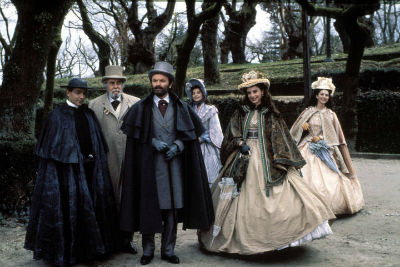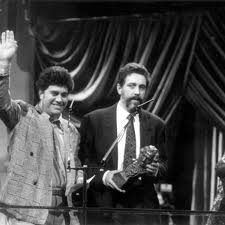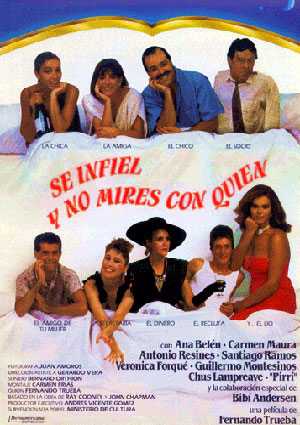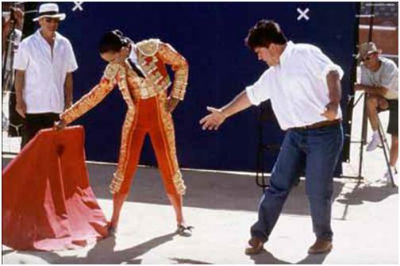In 1983, one of the most important
events in my professional career occurred. Having publicly
supported the Socialist Party, people within the movie industry
thought that I was very close to the new government. The truth of
the matter is that I had only met Alfonso Guerra and Felipe
González in the house of Julio Feo, who was the Chief of Cabinet,
and that was just about it. Alfonso, who was a film buff, had
attended the premiere of some of my films and, at my request, wrote
an article on Buster Keaton, which was published in the newspaperEl
País. Miguel Echarri Jr., who lacked political support and was
convinced that without it nothing could be accomplished, came to
see me to propose a co-production of the series "Los Pazos de
Ulloa" (The Manors of Ulloa), based on the classical work by Emilia
Pardo Bazán. He had a project to that effect, which basically
consisted in some feeble scripts and expected a production manager
by the name of Andrés Velasco - whom he had turned into a director
- to direct the films. I accepted his proposal on the condition
that he let me have the scripts rewritten and that I could choose
an appropriate director. I offered the project to Manuel Gutiérrez
Aragón and Victor Erice. Victor went to his home in the Alpujarra
mountains to give the idea some thought and a few months later told
me "maybe." But by that time I had already assigned the task of
writing the scripts to Manuel and arranged for Gonzalo Suárez to
direct the series.

With Manolo and Gonzalo on board
and a cast that included Victoria Abril, Omero Antonutti, Charo
López and José Luis Gómez, it was relatively easy to convince
Spanish Television, particularly the head of fiction, Juan Manuel
Martín de Blas, to accept the project and finance it entirely. By
then I had already bought Echarri's share in the project. At no
time did I have to depend on any political influence or express any
sympathy towards anyone to get the project rolling. I merely
limited myself to using, perhaps for the first time in my
professional life, the correct production criteria. Manolo didn't
finish the scripts in time, but Carmen Rico Godoy did.
The shooting of "Los Pazos de
Ulloa," as it turned out, was a piece of cake. I followed it on a
daily basis. We built a spectacular set decoration in the old
Bronston Studios of Chamartín. Gonzalo managed to achieve a level
of harmony and complicity with Victoria Abril that was remarkable.
I had to carry out the unpleasant task of terminating the contract
of a young actress, Maribel Verdú, whom we had selected to play the
role of the leading character when she was a teenager. The
excellent relationship between Victoria and Gonzalo enabled Petete
-as the crew started to call Victoria- to play the dual role of the
leading actress in the two different stages of her life - as a
fourteen-year-old girl and a thirty-year-old woman.
"Los Pazos de Ulloa" had at its
disposal a luxury team and undoubtedly the most influential and
distinguished technician, Gerardo Vera, who by then was a
prestigious art director and costume designer. His prior work in
the theater and involvement in some of the movies directed by
Carlos Saura had earned him a well-deserved reputation. Gerardo and
I immediately got on very well with each other. We first met on a
Sunday morning at the terrace of the Café Teide, next door to the
Café Gijón, and he showed to me some sketches for the set
decoration of the Manor where the action was going to take place.
They were absolutely marvelous.
Gonzalo Suárez has always been
admired, and justly so, by young filmmakers both as a writer and a
film director. He is such a personal author that it is possible for
him to be admired and loved by everybody because, given his
peculiarity, he isn't anyone's competitor. Curiously, in those days
amongst those who admired Gonzalo Suárez, were two young men who
didn't even know each other: Fernando Trueba and Pedro Almodóvar.
Fernando was a very good friend of his and Pedro now and then
passed him a type-written script. Thus it was Gonzalo who, for the
first time, started talking well about me to those two young
directors.

At the time, Fernando had released
two films, "Ópera prima" and "Sal gorda" (Rock Salt) and Almodóvar
"Qué he hecho yo para merecer esto" (What Have I Done to Deserve
This?). In those days, Spanish production was so weak and
shortsighted that neither of them had a producer for their next
films.
Close to the end of the 18-week
filming of "Los Pazos de Ulloa," it occurred to me that we should
make a movie using the set decoration of the series: the interior
of a Galician Manor and the complex of a large flat in Santiago de
Compostela. Gerardo committed himself to have them converted into a
large, modern Madrid apartment. I purchased the rights of the
theater play "Move Over Mrs. Markham", a vaudeville piece by John
Chapman and Ray Cooney, which had been very successful in England.
Andrés Kramer, the father of a collaborator of mine named
Margarita, obtained the rights for me and put me in touch with the
owners, the producer, author and theater director Justo Alonso,
Nacho Artime and Jaime Azpilicueta. With the latter I agreed that
he would direct the movie. I asked Manolo Gutiérrez to write the
script but he was very busy with his own projects and travel so
that all I managed was to waste a few weeks of my time. Eventually,
I proposed to Fernando Trueba that he write the script. I had just
met him once before briefly when he showed up in my office to pick
up some photos of Buster Keaton to be used in a review inEl
País,Casablanca or La Guía del Ocio, publications with which he
collaborated. I called Fernando on a Saturday and offered him the
job to write the script. The following day, on a Sunday, we
arranged to meet at the Café de Ópera and spoke about the project.
Later on I found out that he accepted the job against the advice of
his friends who were skeptical about the project. Apparently, that
was because when Fernando asked me what sort of adaptation I
wanted, I told him that I was after one that was completely
unfaithful to the play. My reasoning was very simple though: the
play had been a great success and had been running for five years;
if we followed the text to the letter and failed, people in the
movie business would say we were a bunch of jerks. But, if we were
unfaithful to the play and deviated from the original, they would
only say we were crazy. And I'd rather be called a nut than a
dickhead.
Fernando and I soon got along well.
We started seeing each other once a week; we'd have lunch at the
Casa de Campo and he'd tell me about his difficulties with the
script. We used to talk a lot about cinema and politics and, soon
enough, I was impressed with his talent, intelligence and
intellectual honesty. When he handed me the first forty pages of
the script I knew that he was the right man to direct the film.
When I proposed it to him, Fernando replied with his usual common
sense that I should wait until he finished writing the script. Some
days later, I broke my verbal commitment with Jaime Azpilicueta in
a cowardly letter, because of which I feel compelled to apologize
to him every time I run into him. However, I have never regretted
it because if there is something that is totally true about my
personal and professional memories is that my encounters and
collaboration with Trueba has been the best thing that ever
happened to me as a producer. Together we have created many films -
some of which haven't been shot yet. I have seen his son Jonás grow
up and I have proved and convinced myself that behind a great man
there can be an even greater woman; Cristina Huete.

The shooting of our screen version
of the play, which we called "Sé infiel y no mires con quien."
(Cheat with Whoever You Choose) taught me that there existed a new
way of approaching production that was very different from that
which was typical of Spanish cinema up until then. New directors
like Trueba felt they were more the authors of their films (if that
is indeed possible) than the classics who they admired, but at the
same time they encouraged the rest of their team to participate
more through greater responsibility and by building up their
enthusiasm and motivation. The atmosphere was therefore more
participative, less authoritarian and far more exciting for all
those involved. In "Sé infiel..." I saw actresses and actors like
Carmen Maura, Ana Belén, Chus Lampreave, Verónica Forqué, Santiago
Ramos, Antonio Resines, Willy Montesinos and the late Pirri,
totally committed to the film. It wasn't necessary to participate
in a great movie with a clear message and nonsense to devote
oneself to it fully with love and art. On the day that "Sé
infiel..." premiered, Fernando Split a 500 pesetas bill in two -
one half for himself and the other for me. Ever since, I carry my
half in my wallet as a lucky charm and I sincerely believe that
luck has always been on my side since that day.
While we filmed "Sé infiel..." we
were also producing "Flecha negra" (Black Arrow), a co-production
with Harry A. Towers, financed by L. Ron Hubbart, leader of the
Church of Scientology. The movie was being made for the US Disney
Channel. Given that it was forbidden for the spiritual guides of
Travolta, Cruise and many others to participate in such commercial
ventures, in the credits there is a dedication to L.R.H. (L. Ron
Hubbart). I don't have any outstanding memories about that film
apart from the participation of the brilliant Oliver Reed and the
image of José Garasino stopping traffic at Navacerrada, in what was
his first film as an assistant to the director.
We spent the summer of 1985 in a
rented house in Guadalix de la Sierra, where now and then I would
receive Pedro Almodóvar and Fernando Trueba. I remember Pedro
playing paddle ball with Fernando or bathing in the swimming pool
with Jonás Groucho Rodríguez Huete Trueba (the son of Fernando and
Cristina, who at the time must have been about six years old) while
at the same time shouting: "Jonás, call me mum!" During that
summer, what was to be my only film with Almodóvar and also the
last one he made with a producer other than his brother Agustín,
took shape & form.
Our relationship started well and
ended so-so. I suppose it was Gonzalo Suárez or Javier de Garcillán
who suggested to him to come and see me to offer me his project. It
was based on a script called "Lo inevitable" (The Inevitable),
which he wrote with Jesús Ferrero; Alfredo Matas had promised him
to finance the project through the In-Cine production company. That
company had distributed the films directed by Almodóvar and
produced by Jacques Hachuel with Tesauro. Matas didn't like the
script and he opted to forfeit the funds that were put up in
advance rather than run the risk of making the film.

As soon as Pedro came to see me, we
reached an agreement and signed two films: "Lo inevitable" and "La
ley del deseo" (Law of Desire). My most significant contribution to
"Lo inevitable" was to give it what became its final name,
"Matador." And regarding "La ley del deseo", to free Pedro from his
commitment with me so that he could produce it together with his
brother, with whom he set up the production company "El Deseo." To
produce his own films, he counted on the enthusiastic and useful
help of Carmen Maura and Pilar Miró, both of whom gave him
encouragement and advice.
The excuse Almodóvar gave me when
we realized that we couldn't carry on working together was that he
couldn't stand that I spent the whole day with other directors like
Trueba, Saura, etc. He wanted a producer all for himself. He also
took very badly some critical comments I made about "Matador," so
we decided to break up our alliance. Since then we hate each other,
albeit in my case "cordially" so, although such a mutual dislike
didn't prevent me some years later from asking him to direct
"Perdita Durango" or, as a member of the American Academy, voting
for him when he won an Oscar for "Todo sobre mi madre" (All About
My Mother) in 1999.
Shooting films with Trueba and
Almodóvar, which were filmed and premiered almost simultaneously,
attracted the attention of other filmmakers and finally earned me
recognition in the movie industry. At the time, Romualdo Maldonado,
the owner of Gecisa, a company that dealt in electrical material
rental, introduced me to Juan Manuel Velasco, a financial broker
and middleman with whom I founded the production company Cía.
Iberoamericana de TV, S.A. which subsequently became Iberoamericana
Films Producción, S.A. and Iberoamericana de Derechos
Audiovisuales, S.A. Thereafter, Juan Manuel Velasco and I walked
the long road that took us to Gutiérrez Amador, owner of
Transportes Candi, and later on to the duo: Vicente Vieitez and
Javier Calvo. Subsequently I joined Lolafilms, S.A., a production
company originally based in Barcelona, founded by José Manuel Lara
and Manuel Lombardero. When I joined I also invited Pablo Atienza
and the Gescapital investment bank to participate in the business.
In the mid 1990s I established a brief though fruitful business
relationship with Juan Luis Cebrián and Jesús Polanco's PRISA
GROUP. I then finally arrived at Telefónica with the help of Pedro
Pérez, first with Juan Villalonga and Javier Revuelta as chairman
and vice-chairmen respectively and at present with César Alierta as
chairman.
These few lines summarize my recent
entrepreneurial activities in which my work as a producer has taken
priority. I have always counted on the enthusiastic collaboration
of the people I have mentioned herein, thanks to whom I have been
able to finance over 70 films, almost all of them marked by a
relative coherence. In them, I have sought diversity. In my eager
search for the latter, I have almost always managed to obtain the
involvement of the viewing public, in general or at least some
particular segments of it.